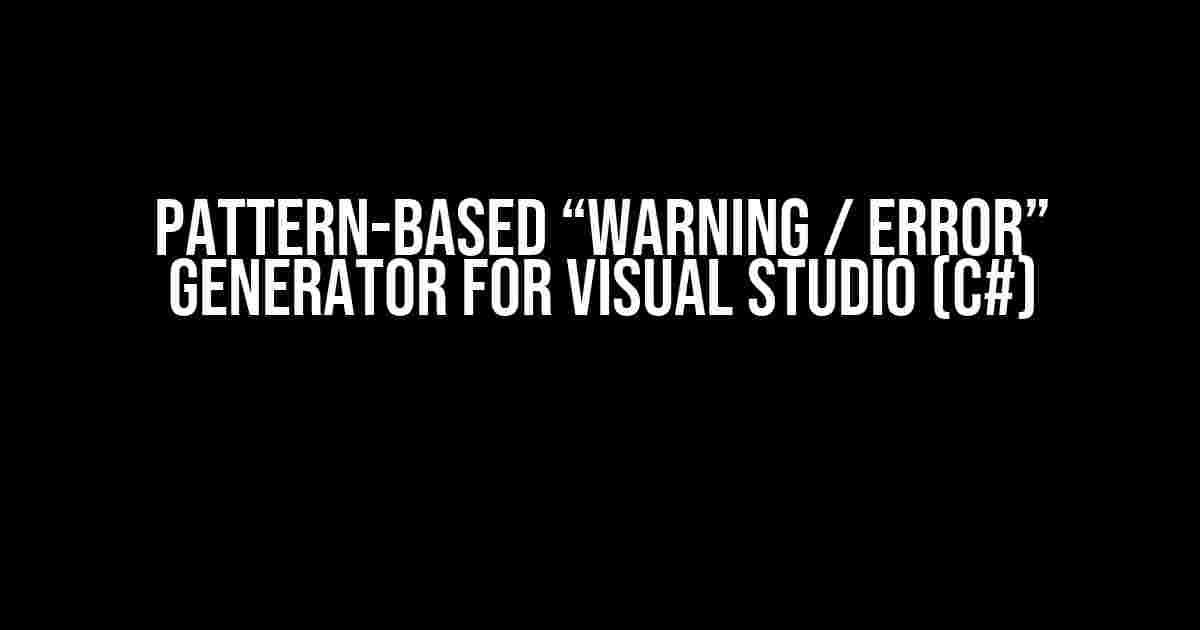Are you tired of manually writing warnings and errors in Visual Studio for your C# projects? Do you wish there was a way to automate this process and focus on more important tasks? Look no further! In this article, we’ll introduce a pattern-based “Warning / Error” generator for Visual Studio using C#, which will revolutionize the way you handle warnings and errors in your projects.
What is a Pattern-Based “Warning / Error” Generator?
A pattern-based “Warning / Error” generator is a tool that uses pre-defined patterns to generate warnings and errors in Visual Studio. These patterns are based on specific conditions, such as code smells, performance issues, or security vulnerabilities, which are common in C# projects. By using a generator, you can save time and effort, and ensure consistency in your warnings and errors.
Benefits of a Pattern-Based “Warning / Error” Generator
- Consistency**: A generator ensures that warnings and errors are consistent across your project, reducing confusion and errors.
- Efficiency**: Automating the process of generating warnings and errors saves time and effort, allowing you to focus on more important tasks.
- Customizability**: You can define custom patterns and rules to suit your project’s specific needs.
- Improved Code Quality**: By identifying and addressing code smells and performance issues, you can improve the overall quality of your code.
How to Create a Pattern-Based “Warning / Error” Generator for Visual Studio (C#)
To create a pattern-based “Warning / Error” generator, you’ll need to follow these steps:
Step 1: Define Your Patterns
Start by identifying the patterns and rules you want to use to generate warnings and errors. These patterns can be based on various criteria, such as:
- Code smells (e.g., long method, switch statement with too many cases)
- Performance issues (e.g., slow database queries, unnecessary iterations)
- Security vulnerabilities (e.g., SQL injection, cross-site scripting)
For each pattern, define the conditions that trigger the warning or error, and the message that will be displayed.
Step 2: Create a C# Class Library
Create a new C# class library project in Visual Studio. This will contain the logic for your pattern-based generator.
using System;
using System.Collections.Generic;
using System.Linq;
namespace PatternBasedWarningErrorGenerator
{
public class WarningErrorGenerator
{
// Define your patterns and rules here
}
}Step 3: Implement the Pattern-Based Generator
Implement the logic for your pattern-based generator in the C# class library. This will involve:
- Parsing the code files to identify the patterns and conditions
- Generating warnings and errors based on the defined patterns and rules
- Returning the warnings and errors to Visual Studio
using System.CodeDom.Compiler;
using Microsoft.VisualStudio.Shell;
namespace PatternBasedWarningErrorGenerator
{
public class WarningErrorGenerator
{
public List<Warning> GenerateWarnings(string code)
{
// Parse the code and identify patterns
// Generate warnings based on the defined patterns and rules
// Return the warnings
}
public List<Error> GenerateErrors(string code)
{
// Parse the code and identify patterns
// Generate errors based on the defined patterns and rules
// Return the errors
}
}
}Step 4: Integrate with Visual Studio
To integrate your pattern-based generator with Visual Studio, you’ll need to create a Visual Studio extension package. This will allow you to:
- Register your generator with Visual Studio
- Display the warnings and errors in the Visual Studio error list
using Microsoft.VisualStudio.Shell;
namespace PatternBasedWarningErrorGenerator.VisualStudioExtension
{
public class PatternBasedWarningErrorGeneratorPackage : Package
{
public PatternBasedWarningErrorGeneratorPackage()
{
// Register the generator with Visual Studio
}
}
}Example Pattern-Based “Warning / Error” Generator
To illustrate how this works, let’s create a simple pattern-based generator that identifies long methods in C# code.
Pattern Definition
| Pattern | Condition | Warning/Error Message |
|---|---|---|
| Long Method | Method has more than 20 lines of code | “Method ‘{0}’ has {1} lines of code, which is considered long. Consider breaking it up into smaller methods.” |
Implementation
using System.Linq;
using Microsoft.CodeAnalysis;
using Microsoft.CodeAnalysis.CSharp;
using Microsoft.CodeAnalysis.CSharp.Syntax;
namespace PatternBasedWarningErrorGenerator
{
public class LongMethodWarningGenerator
{
public List<Warning> GenerateWarnings(string code)
{
var syntaxTree = CSharpSyntaxTree.ParseText(code);
var compilation = CSharpCompilation.Create("LongMethodWarningGenerator").AddSyntaxTrees(syntaxTree);
var warnings = new List<Warning>();
foreach (var method in syntaxTree.GetRoot().DescendantNodes().OfType<MethodDeclarationSyntax>())
{
var methodBody = method.Body;
if (methodBody.Statements.Count() > 20)
{
warnings.Add(new Warning(string.Format("Method '{0}' has {1} lines of code, which is considered long. Consider breaking it up into smaller methods.", method.Identifier.Text, methodBody.Statements.Count())));
}
}
return warnings;
}
}
}In this example, we define a pattern for long methods, which are methods with more than 20 lines of code. We then implement the logic to generate warnings for these methods, using the Roslyn compiler API to parse the code and identify the method bodies.
Conclusion
In this article, we’ve introduced a pattern-based “Warning / Error” generator for Visual Studio using C#. We’ve shown how to define patterns and rules, implement the generator logic, and integrate with Visual Studio. By using a pattern-based generator, you can automate the process of generating warnings and errors, and improve the overall quality of your code.
Remember, this is just a starting point, and you can customize and extend the generator to fit your specific needs. So, get creative and start generating those warnings and errors!
Download the Source Code
You can download the source code for this article from [insert link]. This includes the C# class library project, the Visual Studio extension package, and the example pattern-based generator.
Conclusion
Pattern-based “Warning / Error” generators are a powerful tool for improving code quality and reducing errors in Visual Studio. By automating the process of generating warnings and errors, you can focus on more important tasks and ensure consistency across your projects. So, start creating your own pattern-based generator today and take your coding to the next level!
Here are 5 Questions and Answers about “Pattern-Based “Warning / Error” Generator for Visual Studio? (C#)” :
Frequently Asked Question
Get your doubts cleared about Pattern-Based “Warning / Error” Generator for Visual Studio? (C#) with these frequently asked questions!
What is Pattern-Based “Warning / Error” Generator for Visual Studio?
The Pattern-Based “Warning / Error” Generator for Visual Studio is a tool that allows developers to generate warnings and errors in their C# code based on specific patterns. This tool is designed to help developers identify potential issues in their code and ensure that it meets certain coding standards.
How does the Pattern-Based “Warning / Error” Generator work?
The tool works by analyzing the C# code and identifying patterns that match specific rules. These rules are defined by the developer and can be based on various criteria such as code structure, naming conventions, and syntax. When a pattern is detected, the tool generates a warning or error message that appears in the Visual Studio error list.
What kind of patterns can I define with this tool?
You can define a wide range of patterns using this tool, including patterns based on code structure, naming conventions, syntax, and more. For example, you can define a pattern to detect unused variables, methods with too many parameters, or classes with incorrect naming conventions.
Can I customize the warning and error messages generated by the tool?
Yes, you can customize the warning and error messages generated by the tool to fit your specific needs. You can define your own custom messages and even specify the severity of the warnings and errors.
Is the Pattern-Based “Warning / Error” Generator compatible with all versions of Visual Studio?
The tool is compatible with Visual Studio 2017 and later versions. However, it’s recommended to check the compatibility before installing the tool.


